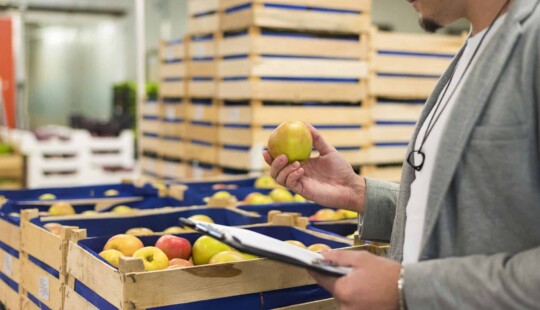The food we eat, clothes we wear and the buildings we live in are all contributing to the biggest challenge for humanity in the 21st century: climate change.
One-third of all food around the world is thrown away, creating not only an environmental disaster but a social and economic one, considering that 815 million people are undernourished and food waste costs the global economy more than US$2.6 trillion per year.
The fashion industry generates 10 percent of global greenhouse gas emissions due to its long supply chains and energy intensive production. In addition, the average consumer throws away 31 kilograms of clothing per year, most of which ends up in landfills.
And did you know that concrete is the most destructive material on earth? Yet it continues to be the foundation of modern development, destroying natural habitats, creating overheated urban jungles, and trapping gases from car exhaust and air-conditioning units.
Circular Solution
More and more business and industry experts agree that a shift from the current linear “take-make-waste” approach to a circular economy would help create the necessary framework to halt these destructive trends and lay the foundation for a new, regenerative system.
Earlier this month, pivotal industry figures shared their expertise and experience on these topical themes as part of the Circular Design Project, supported by SAP and the Ellen MacArthur Foundation in collaboration with the 2020 London Design Festival. Five sessions were set up to equip and inspire the global design community to view the circular economy as a framework for creating positive global impact.

Begin with Design
Waste and pollution are the result of flaws in design. Ninety percent of environmental impact occurs at the design stage of a product, which is why the three principles of circularity are the key to a more sustainable future.
During the first session, Andrew Morley, CEO of the Ellen MacArthur Foundation, explained that circularity is a simple idea. “We need to think about how materials flow through the economy and find ways to use them more efficiently and effectively,” he said. “The first step is to design out waste and pollution upfront, then we need to keep products and materials in use as long as possible, by design, and lastly we need to regenerate natural systems.”
Regarding the role of design, Tim Brown, executive chairman of global design consulting organization IDEO, put it succinctly: At its highest level, design is about shaping the world to meet our needs.
“What needs to change is the way we shape, or design, the world we live in,” Brown said. “We can no longer design based on desire and profitability but must shift to design based on sustainability and equitability.” He added that the role of a designer is to imagine how it could be and highlighted the fact that there are 160 million designers out there, each of whom has the decision-making power to shape a new world free of waste.
SAP Chief Sustainability Officer Daniel Schmid elaborated on the role of technology in the journey toward circularity and emphasized the need for the right tools, data, and best practices to help designers understand circularity and their own critical role.
Designing the Future
The remaining sessions featured innovative solutions to the core problems associated with producing materials, food, clothing, and buildings.
The sessions on materials and built environments emphasized the need to create a circular future where there is no such thing as waste. There is no “away” when we throw something away; we simply move it from one place to another. If the object is organic, like a leaf, it reenters nature’s regenerative cycle. But most materials we use today for producing clothing and buildings are manmade.
We are currently living in the Anthropocene Era, which refers to the commencement of significant human impact on Earth’s geology and ecosystems. This year, 2020, marks the moment manmade matter surpassed the amount of biomass on our planet.
Experts like Thomas Rau, founder of Rau Architects, believe it is important to understand the difference between sustainable and circular design. “Sustainable design is about optimizing systems to reduce waste, the use of resources, and so on,” Rau said. “But circular design begins with the notion that everything is limited, and our existence as humans — our needs — are temporary. We need to look at buildings as depots for materials that can be reused 100 years from now.”
Going Circular
When it comes to clothing, the discussion centered on the need to do much more at a much faster rate. On one hand, the fashion world has never been closer to going circular. But on the other, it is so far away that experts like Erik Liedtke are alarmed at the slow pace at which large companies are willing to change. Liedtke — who launched the Parley for the Oceans program at Adidas and later left his role as executive board member responsible for Global Brands to become a self-proclaimed free agent fighting waste — says the only way to hurry the process along is to make profit the carrot.
Additionally, food waste remains one of the greatest challenges, because not only is the current linear model of food production and distribution incredibly wasteful, what is wasted could be feeding millions of people who are going hungry every day.
Jasmine Crowe, CEO of Goodr, took action by collecting leftover food from restaurants, company canteens, and institutions like airports then delivering it to shelters and food banks. “Seventy-five billion pounds of perfectly good food is wasted every year in America,” she shared. “The idea that hunger is an issue of scarcity and that we need to produce more food is false. Hunger is an issue of logistics, so our goal is to solve the surplus food supply chain problem.”
Crowe and others in the industry like Martin Dickie agree that the only way forward is through a circular economy. Dickie is the founder of Brewdog, the UK’s best-selling craft beer company that also happens to be carbon negative, meaning the company removes carbon dioxide from the air instead of adding to it.
“We need to make it shameful to waste food,” said Dickie, who has taken David Attenborough’s waste not, want not message to heart.
The experts who contributed to the Circular Design Project all share a sense of urgency. They also know that no single organization, brand, or government can achieve pivotal change alone. Viewing the pandemic as an opportunity, they also agree there is no better way to restart the economy than by engaging millions of designers around the world to make the right decisions when it comes to designing our future world.
Watch session recordings here.
Follow me on Twitter: @magyarj



